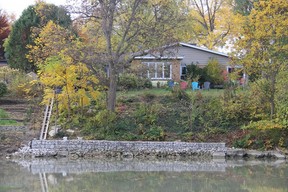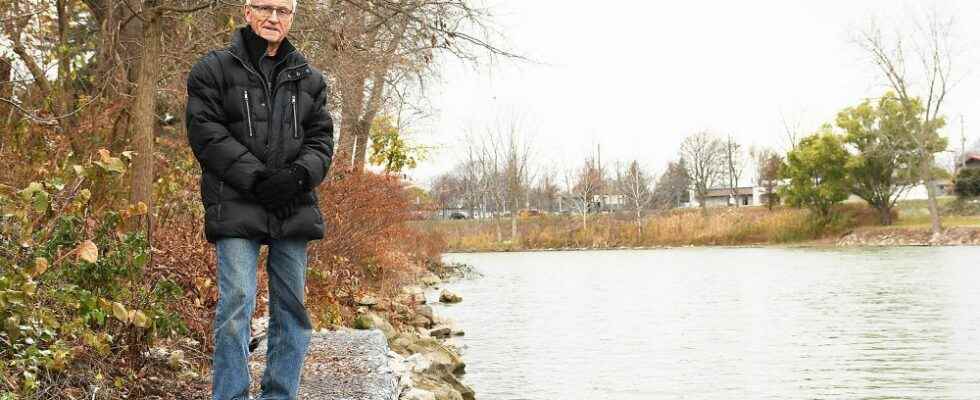
Faced with high quotes from contractors, a Chatham man living on the Thames River took on a project to build a wall on the shoreline of his property as an erosion control measure.
Tony Hill worked with two others to install the 44-foot-long and two-foot-high gabion wall. A gabion is a caged structure that can be filled with rocks.
Hill said the erosion had started to cut into the riverbank on his property and he first called the Lower Thames Conservation Authority last fall. The authority directed him to file a permit if he would have any work done and gave names of construction companies, he said.
After consulting with three companies, Hill said they gave him quotes in the $40,000 to $55,000 range. His property also doesn’t have access for heavy vehicles on either side of the house, so some of the quotes involved taking down a hedge, which would have affected his neighbour.
“I set about to learn something about erosion control. I’ve always been keen on it,” Hill, who grew up on the Credit River in Ontario, said.
By working on the wall himself, Hill said he spent about $8,000. He plans to complete the remaining 36 feet of shoreline at an estimated cost of $4,000 to $5,000.
Hill acknowledged his engineer friends all told him to find someone else to complete the project for him.
“But there was nobody who was capable,” he said. “Once I had a proper plan, there was still nobody that was actually interested in the job at all.”
He said the issues with the project for the contractors was getting the materials past the driveway and a shortage of construction workers.
Hill found the gabion structures from a company in Kitchener. He purchased two of the cages that were one-foot high each and started the job in April.
“The water level was just above where I needed to put the gabions – inches – and it was really rough rock,” he said. “We managed to clear out the debris and then put a flat bed of stone … and then we put down two rows of gabions.”
Hill and his two workers wheelbarrowed the rocks from a pile in his driveway to the backyard.
There, they put the rocks in blue recycle bins and used a 32-foot slide to move the bins down the slope to the river. Hill said he is also using the slide to launch his kayak into the Thames.
“I paddle up and down the river and the number of properties that are as bad as mine – some worse, some not as bad – right through the town is a lot,” he said.
Hill completed the first phase of the job in early November.
Jason Wintermute, manager of watershed and information services for the Lower Thames Valley Conservation Authority, said he has no preference between contractors or individuals taking on these projects as long as they are done properly.
He said if others want to start this type of job, they should know permits are needed from the authority’s office. Since there are species at risk in the Thames River near Chatham, he said both contractors and individuals should also check with Fisheries and Oceans Canada and the Ontario Ministry of Environment, Conservation and Parks.
“That’s always a good thing to check on because there are definitely known species at risk through the Thames River in this lower portion,” Wintermute said.
Wintermute said an engineer can also help determine the best type of structure to use to deal with the erosion on a specific property.
“If there is significant erosion, we generally don’t encourage walls because what a wall tends to do is it tends to create downcutting of the river bed, or the lake bed if you’re talking at the bed of the lake, right at the toe of the wall,” he said.
“That tends to deepen that area, leading to challenges with the wall.”

People often prefer walls, Wintermute said, because of how they look. When there is significant erosion, he said the preferable alternate is usually the revetment style, which has a sloped structure.
Wintermute noted the Municipality of Chatham-Kent used the revetment style west of Chatham on a section of Riverview Line.
“There are challenges with walls. If you don’t have significant erosion, then it might be OK, but if you’ve got a significant erosion problem, it’s probably best to speak to an engineer,” he said.
Using natural materials such as plants is another option to consider, Wintermute said.
There are other areas of the Thames in Chatham where there is significant erosion, he said, but some areas haven’t seen much erosion for decades.
Hill said he hopes others living on the Thames will consider whether their properties need erosion control measures.
“Jennifer (Hill’s wife) and I are both really interested in nature and what is going on, on the river,” he said. “It’s better for the river to not have mud sliding into it every spring.”
